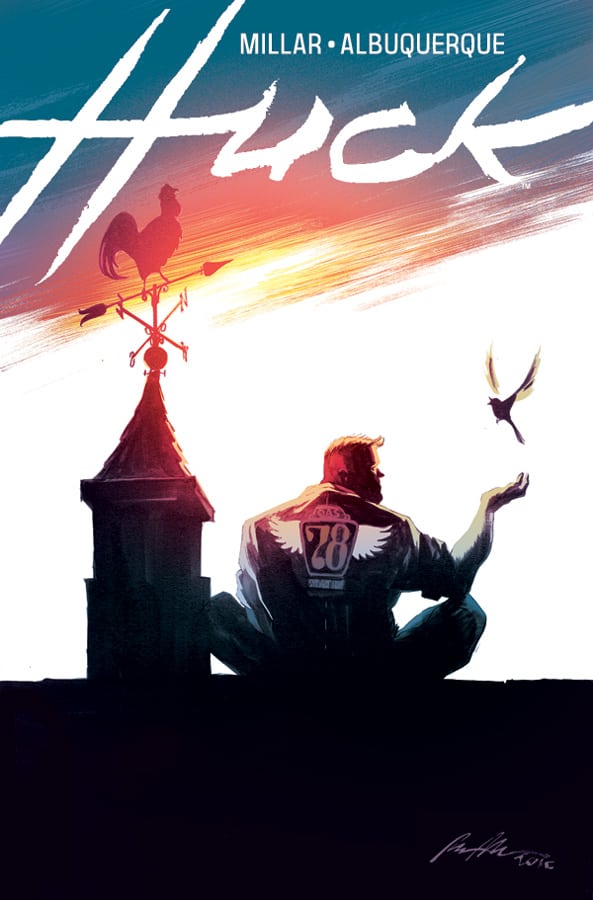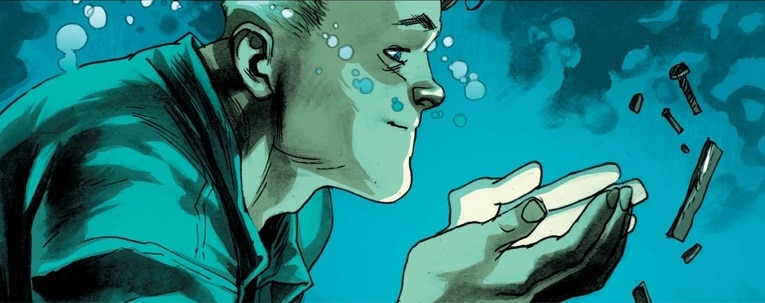
“I like doing different things,” said Millar via Skype interview today. “In the past two, three years I have tried to mix things up.”
Many know Millar for darker stories he has come up with, like those in the controversial Kick-Ass comics, but this upcoming comic follows the titular Huck, a genuine and kind man reminiscent of the biblically-based “Good Samaritan” archetype. The character was raised from birth to do a good deed every day, and that is exactly what he does as a grown man for the ordinary folks of his neighborhood.
During some charity work he participated in last year, Millar met an elderly man visiting on a vacation for two weeks who heavily inspired the character of Huck, he explained.
“The two weeks he was there, he just kept doing things for me,” said Millar. “I was there helping out, but he would get me a cup of tea and then he went and got me a chair and everything.”
Millar was enamored by this man’s actions, which became burned into his brain, he explained.
“He had learning difficulties and he was socially very shy,” said Millar. “Every time he did something he would say ‘that’s my good deed done.’”
This man he met told Millar he lives according to a daily goal of accomplishing one good deed, just like the character he unknowingly inspired. Huck is sort of like a combination of Forest Gump and Captain America, Millar explained.
“It’s a guy who’s just really pure and really decent,” he said explaining the Forest Gump connection, “and the Captain America idea of just helping you out, that very idealistic idea of what it means to be an American.”
Growing up in Scotland, Millar had a specific perspective of America.
“As a kid I wanted to be American because it seemed really forward-looking, and the projection of America, certainly in movies and comics, seemed obviously really glamorous,” he explained. “I kind of liked the idea of that, that ‘truth, justice and the American way’ kind of thing, but just stretched right out to its simplest form.”
It’s this vision from his youth of America and what it means to be an American that formed some of the basis of Huck, he explained.
“I wanted to create almost an American folk hero,” he said. 
The character and overall tone of the book is something refreshing for Albuquerque, he explained, known for his work on darker books like the horror comic American Vampire written by Scott Snyder.
“Comics lately are being more and more dark, and more and more gritty, and the heroes are more and more anti-heroes, much more so than the classic heroes,” said Albuquerque in a Skype interview on Monday. “[A]nd I don’t really remember if I had the chance to work on such an optimistic and pure character before.”
Millar saw an American flair in Albuquerque’s prior work, which helped tip the scales in favor of wanting Albuquerque, a Brazilian, as his partner on Huck, he explained.
“He does have kind of a John Steinbeck, Of Mice and Men quality to his work,” Millar said. He later went on to say some of Albuquerque’s work conjures up a “blue collar, mid-west American kind of look” for him.
Albuquerque loves Millar’s work and had been pining for the day he could work with him.
“When he called me it wasn’t really an opportunity I could pass,” said Albuquerque.
The first issue of Huck features more than a few pages and panels without dialogue or narration, following scenes of action and others focusing on gentle expression. This provided a challenge for Albuquerque, but he still happily embraced it, he explained.
“Sometimes in comics, dialogue can be helpful for the best storytelling, so that kind of pushed me to do the best sort of storytelling that I can,” said Albuquerque.
The comic’s narrative will unfurl in six-issue arcs that will snugly fit into a trade paperback, Millar explained. The optimistic story of Huck won’t just be found on the pages of books, though; Huck is set to release as a major motion picture, via Studio 8.
It isn’t the first time Millar’s work has been turned into a film, like the comic Kick-Ass that started in 2008, co-created with John Romita Jr., which turned into the 2010 movie called the same. The Marvel Comics series he wrote called Civil War is even the basis for the upcoming third movie in the Captain America series next year. Despite this, he doesn’t write comics any differently knowing they may very well turn into a movie; in fact, he doesn’t even understand how he could.
“In terms of a number of scenes, a six-issue graphic novel is generally structured almost identically to a movie,” said Millar. “Six issues of a comic is roughly the same amount of time that you’ll spend in a movie in terms of scenes.”
Millar went on to explain the structure of a graphic novel, which “all comics now are written for,” and its similarity to typical, three-act structure of movies.
“They have an interesting opening sequence, they have events that happen, and they have a third act where the situation is resolved,” said Millar.
He thinks it is a bad idea for a writer to try to emulate a “movie style” when writing a comic they hope will obtain a movie adaptation.
“The stuff that’s just a little more odd is the stuff that actually speaks to people a lot more,” said Millar. “For some reason it’s the stuff the movie studios are very interested in if you do something that’s just your personal, weird little comic”
Also, writing comics is simply his thing.
“When I was five I wanted to do comics, and if anyone wants to make lunchboxes or movies or video games or whatever out of my comics, fantastic, but I don’t want to get into the lunchbox business and I’m not that interested in being a filmmaker,” said Millar. “For me I love having a pen and paper.”
Check out Pop Optiq’s advance review of the first issue of Huck here.
Check out Matt’s online portfolio here.


